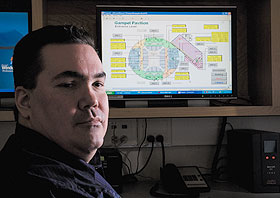  |
| HOME | THIS ISSUE | CALENDAR | GRANTS | BACK ISSUES | < BACK | NEXT > |
Computer program adjusts heating, cooling, and waterby Richard Veilleux - March 23, 2009 |
||||
| When a diagram of Gampel Pavilion popped up on Peter McQueeney’s computer screen indicating that the temperature was more than 90 degrees in the building’s dome, he wasn’t surprised. “It’s probably because there was an event there last night,” he said. But he was able to do something about it without even leaving his desk. McQueeney, UConn’s energy management supervisor, guided his cursor to a box on the lower left of his computer screen, typed in the number 68, and clicked “accept.” Within a few hours, he said, Gampel would cool down. McQueeney, who works in Facilities Operations, is in charge of the Andover Controls Building Automation System, a computer program interfaced with building mechanical systems. The system enables him to monitor and adjust a building’s heating and cooling systems, air intake, air quality, and more, all from the computer in his office. The system has a server and a dozen workstations in constant communication with network controllers connected to “device controllers.” These controllers, installed in more than 100 buildings on the Storrs campus, receive information from more than 20,000 points and send control signals to over 13,000. The Andover system also manages systems at the Stamford Campus, either locally or from the Storrs campus. Thomas Callahan, UConn’s associate vice president for operations and administration, says the system, which is being continuously upgraded, now covers a majority of the University’s square footage. The system also allows McQueeney and others in his department to monitor the University’s water supply system, managing the amount of water heading into UConn’s storage tanks via the Willimantic and Fenton wellfield pumps, and monitoring the levels of chemicals in the water.
“The system increases our ability to manage and control the water – the gallons per minute we pump and how long we pump each day,” McQueeney says. “It’s a major upgrade over how we handled water use in the past.” The system also saves the University money, says Callahan, although it’s hard to quantify. “More importantly it helps us understand where the energy is going,” he adds, “and that helps us improve the electrical, steam, and chilled water systems.” The control system provides a fail-safe, with defaults built in for maximum and minimum temperatures. Building managers can get the temperature in their building adjusted by making a quick call to facilities operations. If the adjustment doesn’t work, they know there’s something wrong with the system and facilities can dispatch a repair crew. “It shows alarms where something isn’t working,” says Ron Gaudet, energy services manager in facilities operations. “That allows us to focus the management team where it’s needed. The system has been a great help.” |
| ADVANCE HOME UCONN HOME |

